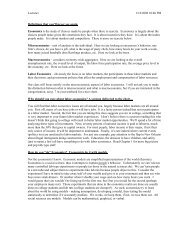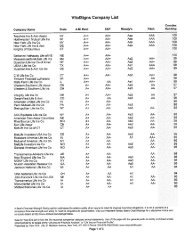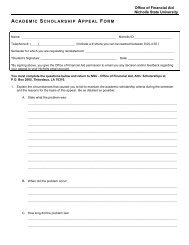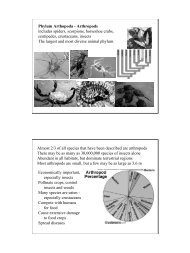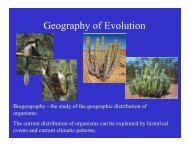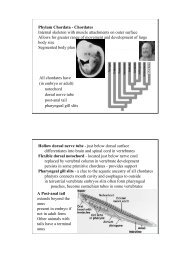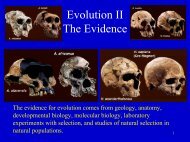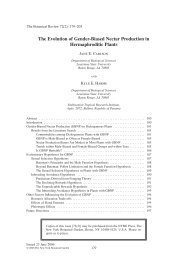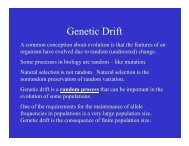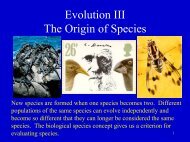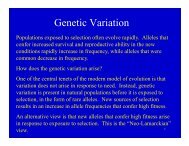Patterns of Evolution.pdf - Nicholls State University
Patterns of Evolution.pdf - Nicholls State University
Patterns of Evolution.pdf - Nicholls State University
Create successful ePaper yourself
Turn your PDF publications into a flip-book with our unique Google optimized e-Paper software.
<strong>Patterns</strong> <strong>of</strong> <strong>Evolution</strong>
A tree that represents an estimate (hypothesis) <strong>of</strong> evolutionary<br />
relatedness is a phylogeny<br />
Classifications can be based on groupings g within a phylogeny<br />
y<br />
Groupings can be categorized<br />
• monophyletic - a group that includes all <strong>of</strong> the descendants <strong>of</strong><br />
a single common ancestor<br />
• paraphyletic - a group that includes some, but not all, <strong>of</strong> the<br />
descendants d <strong>of</strong> a single common ancestor<br />
• polyphyletic - a group that is not based on common ancestry
Traditional classifications were <strong>of</strong>ten based on branching<br />
patterns and apparent amounts <strong>of</strong> evolution. This <strong>of</strong>ten<br />
creates paraphyletic groupings (e.g. Class Reptilia).<br />
Modern<br />
classifications<br />
tend to be<br />
constructed using<br />
monophyletic<br />
groups and<br />
reflect only the<br />
branching pattern<br />
<strong>of</strong> the phylogeny.
Once the<br />
phylogeny hl <strong>of</strong> a<br />
group is known<br />
other inferences<br />
about<br />
evolutionary<br />
history can be<br />
made:<br />
•Segmentation<br />
has evolved<br />
twice.<br />
• Sight has<br />
evolved multiple<br />
times.
Did the ancestor <strong>of</strong> humans and chimps have opposable toes?<br />
If not, then opposable toes must have evolved again in the<br />
chimp lineage.<br />
If so, then opposable toes were lost in the human lineage.<br />
The simpler answer is usually preferred.
Important inferences are made from analysis <strong>of</strong> phylogenies<br />
Features <strong>of</strong> an organism almost always evolve from a preexisting<br />
feature present in their ancestors - complex characters<br />
don’t evolve de novo.<br />
Wings evolved from forelimbs at least 3 times in<br />
vertebrates (birds, bats, pterodactyls)<br />
Wings and forelimbs are homologous characters - they arise from<br />
the same embryonic structures and their development is controlled<br />
by the same genes.<br />
Homology is established by<br />
• correspondence <strong>of</strong> position<br />
• correspondence <strong>of</strong> structure<br />
• correspondence in development<br />
• continuity from an inferred ancestor in a phylogeny
Homoplasy (multiple<br />
origins <strong>of</strong> the same character<br />
state) is common.<br />
Independent evolution <strong>of</strong><br />
similar characteristics in<br />
homologous structures is<br />
called parallel evolution -<br />
a type <strong>of</strong> fhomoplasy.
Independent evolution <strong>of</strong> similar characters through different<br />
Independent evolution <strong>of</strong> similar characters through different<br />
developmental pathways is called convergent evolution -<br />
another type <strong>of</strong> homoplasy
Convergent and parallel evolution are <strong>of</strong>ten due to independent<br />
adaptation to similar environments.
<strong>Evolution</strong>ary reversals are common. The ancestral state <strong>of</strong><br />
a character can re-evolve.<br />
The jawless fishes were the first to evolve bone - as<br />
protective armor over the outside <strong>of</strong> their body.<br />
Modern descendants <strong>of</strong> the<br />
early jawless fishes have<br />
bodies lacking bone entirely.<br />
e
Mosaic evolution is common. Species characteristics <strong>of</strong>ten<br />
evolve independently d <strong>of</strong> each other.<br />
Every organism has a mix <strong>of</strong> ancestral and derived character<br />
states. Slow evolving characters are called conservative<br />
characters. They are retained even though other characters<br />
change.<br />
In terrestrial vertebrates, walking on four legs is a conservative<br />
character. Having 5 digits on the appendages is also<br />
conservative. Having incisors i in the upper and lower jaws is<br />
conservative character.
Change in form is <strong>of</strong>ten related to a change in function.
<strong>Evolution</strong> is usually gradual (gradualism)<br />
Intermediates are <strong>of</strong>ten seen in the<br />
fossil record.<br />
Living organisms <strong>of</strong>ten<br />
exhibit gradual variation in<br />
form.
Species similarity changes during ontogeny.<br />
von Baer’s Law: Development<br />
proceeds from the general to the<br />
specific. - During embryonic<br />
development, the characteristics<br />
<strong>of</strong> the broader taxonomic<br />
categories are seen in the<br />
embryo before the<br />
characteristics <strong>of</strong> the more<br />
specific taxonomic category.<br />
The biogenetic law: “ontogeny recapitulates phylogeny” is not<br />
literally true. Organisms do not develop by progressing<br />
through h the body types <strong>of</strong> their ancestors.
Developmental processes underlie some patterns <strong>of</strong> morphological<br />
evolution.<br />
Individualization -<br />
the taking on <strong>of</strong><br />
specific forms and<br />
functions in a serially<br />
repeating character.
Heterochrony - an evolutionary change in the timing or rate <strong>of</strong><br />
developmental levents.<br />
Paedomorphosis - the retention <strong>of</strong> larval or juvenile<br />
characteristics after the attainment <strong>of</strong> sexual maturity - due to<br />
the relative increase in the rate <strong>of</strong> maturation <strong>of</strong> the gonads<br />
Peromorphosis - the delaying <strong>of</strong><br />
sexual maturation and prolonging <strong>of</strong><br />
the juvenile period in a way that<br />
results in greater development <strong>of</strong><br />
some adult features - e.g. an increase<br />
in cranium volume.
Allometry - differences in growth rate among different parts or<br />
dimensions i <strong>of</strong> an organism.
Although throughout evolutionary history there has been trend <strong>of</strong><br />
increasing complexity, decreases in complexity are also common.<br />
Vertebrate evolution is characterized by many examples <strong>of</strong><br />
simplification <strong>of</strong> structures
Adaptive radiation - the diversification <strong>of</strong> a genetic lineage into<br />
many species with many different adaptations to different aspects<br />
<strong>of</strong> the environment - is common in some groups.
One <strong>of</strong> the most dramatic examples <strong>of</strong> adaptive radiation is that <strong>of</strong><br />
the cichlid fishes <strong>of</strong> the Great Lakes <strong>of</strong> Africa. In the largest 3<br />
lakes (Victoria, Tanganyika, and Malawi), speciation and<br />
adaptation has resulted in “species flocks” that fill different<br />
ecological niches. It happened independently in each lake, but has<br />
given rise to species with similar habits and a similar range <strong>of</strong><br />
morphological diversification.




